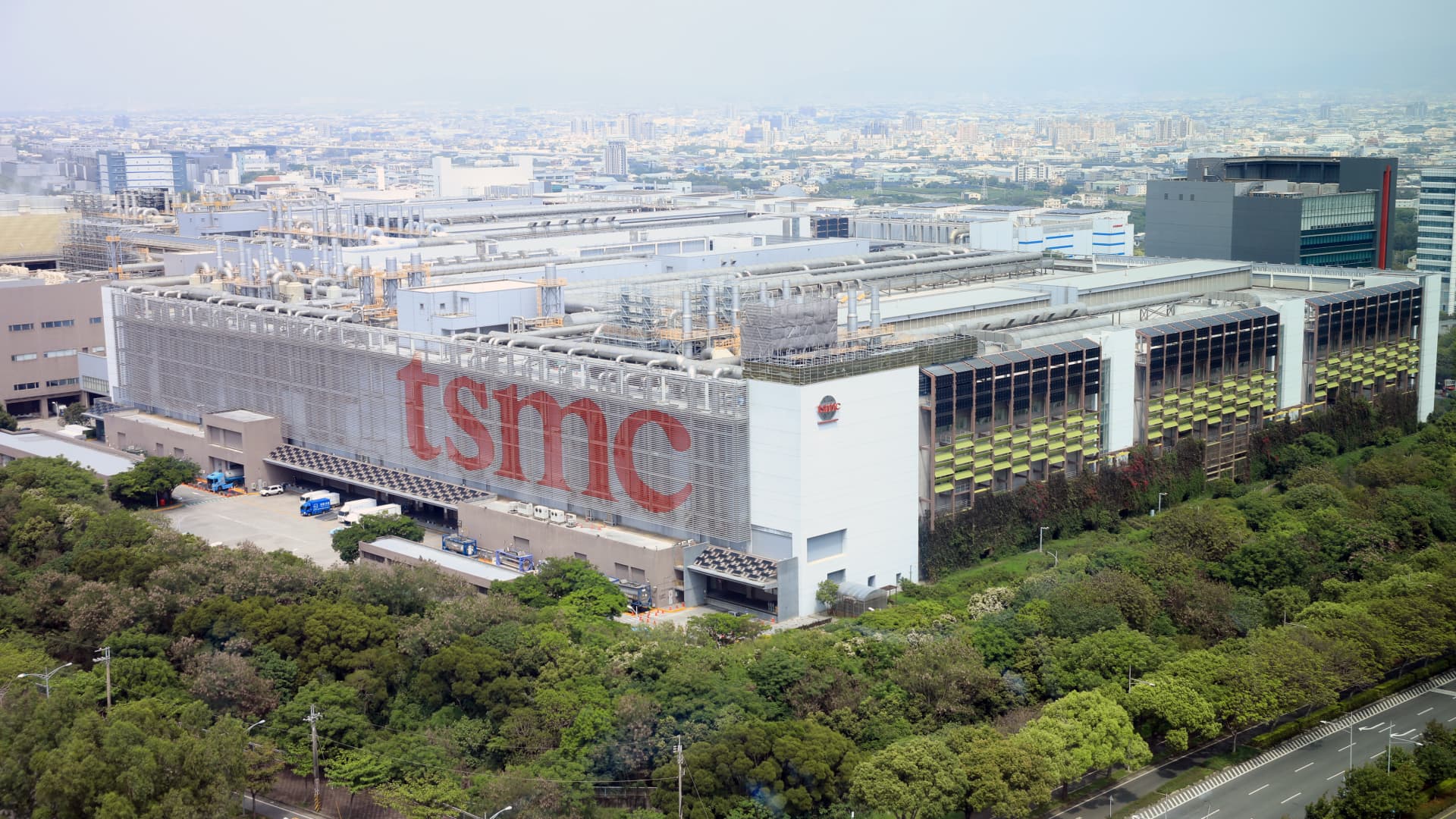Taiwan is home to more than 90% of the manufacturing capacity for the world’s most advanced semiconductors, according to a 2021 Boston Consulting Group report. Pictured here is a TSMC building in Taiwan on April 8, 2022.
Bloomberg | Bloomberg | Getty Images
BEIJING — When it comes to semiconductors, China needs Taiwan more than the other way around.
Beijing halted some trade with the island this month after U.S. House Speaker Nancy Pelosi’s controversial trip to Taiwan.
Notably, the bans didn’t touch electronics. Taiwan is home to more than 90% of the manufacturing capacity for the world’s most advanced semiconductors, according to a 2021 Boston Consulting Group report.
Pelosi’s itinerary included a visit with Taiwan Semiconductor Manufacturing Company, the world’s largest and most critical chip manufacturer. Its products are an integral part of everything from consumer products to military aircraft.
But just 10% of TSMC’s revenue comes from China, according to the company. More than half of its revenue comes from the United States.
“As we speak, the status quo is that these chip companies may not be as dependent on China as the other way around,” said Patrick Chen, head of research for CLSA in Taiwan.
“I think the real challenges for these companies are still coming from the end demand, rather than what’s going on geopolitically,” he said.
American chipmakers Micron and Nvidia have warned in recent weeks about falling demand for products that use their chips.
TSMC’s critical role
Pelosi’s Taiwan trip came despite warnings from Beijing, which considers the democratically self-ruled island part of its territory, with no right to conduct foreign relations independently. The U.S. recognizes Beijing as the sole legal government of China, while maintaining unofficial relations with Taiwan.
In addition to some trade bans, Beijing has stepped up military exercises around the island of Taiwan, raising concerns about the risk to global access to critical chips.
Analysts emphasized that Taiwan-made chips, especially TSMC’s, are too important to the world and to China for any major disruption on the chip front.
“If you look at the secular demand drivers, cloud infrastructure, electric vehicles, next generation of industrial facilities, they all require chips that are made at TSMC,” said Mehdi Hosseini, senior tech hardware analyst at Susquehanna.
“If, God forbid, TSMC’s fabs in Taiwan cannot operate, I think the global economy would slow down more so than what Covid did [to growth],” he said.
CLSA’s Chen described TSMC as being in “a league of its own,” Taiwanese semiconductor companies UMC and America’s GlobalFoundries as tier two chipmakers and China’s SMIC and Hua Hong Semiconductor as falling into tier three.
“In terms of competition, coming from China, it’s not a real, meaningful threat to be expected anytime soon,” he said.
China’s chipmakers are still behind
Beijing has ramped up its chip-building efforts in the last few years, with supportive policies drawing a flood of private capital. State-owned chip company Tsinghua Unigroup’s debt pileup and default show how the system has been prone to waste, despite recent growth and tech development at another Chinese chip giant, Semiconductor Manufacturing International Corporation.
Still, it took SMIC 15 years to get to where TSMC was 10 years ago, Hosseini said in a phone interview last week.
“China does not have access to leading edge equipment,” he said. “It would take a long time to have the engineering knowhow.”
Under the Trump administration, the U.S. essentially banned Chinese tech giants Huawei and SMIC from using American technology, including its chipmaking equipment.
That meant that since late 2020, TSMC could no longer manufacture semiconductors for Huawei.
TSMC’s China revenue had grown between 2018 and 2020 to nearly 20% of overall revenue, according to David Hsu, associate director at S&P Global Ratings.
But in 2021 TSMC’s exposure to China dropped back to around 10% of overall revenue, similar to levels seen in 2017, Hsu said. “After the Huawei ban, [TSMC] shifted its capacity to other companies.”
TSMC’s business has remained strong. The company, which is a major Apple supplier, reported second-quarter revenue of about $18 billion, up by more than 40% from a year ago.
That shows how much larger TSMC is than SMIC, which reported revenue for the same quarter of $1.9 billion, also up by more than 40% from a year ago.
A balancing act with the U.S.
The U.S. is also trying to fortify its access to critical semiconductor tech. U.S. President Joe Biden signed into law this month the Chips and Science Act, which offers subsidies to chipmakers for manufacturing in the U.S.
Bernstein analysts said in a report this month they expect a “lukewarm” impact for TSMC.
“Strategically TSMC is ‘everybody’s foundry’ in order to diversify customer base to reduce risk and increase scale, and will strive to stay neutral in the competition of the US and China,” the report said. “Considering these, we think TSMC likely will still keep its overseas capacity expansion in check in the next few years even with the incentive of the CHIPS Act now.”
About 10% of TSMC’s capacity is in mainland China, versus a far smaller fraction in the U.S., according to Bernstein estimates for the fourth quarter.
TSMC is spending $12 billion to build a factory in Arizona. In mainland China, the company operates in Shanghai and Nanjing.
However, CLSA’s Chen said the Arizona facility will focus on more advanced technology, while Taiwan’s restrictions on chipmakers’ investment into China means manufacturing there will remain focused on older, legacy technology — for which there’s a large market on the mainland.
— CNBC’s Michael Bloom and Arjun Kharpal contributed to this report.

















.jpg?itok=F2C4uk0x)



Discussion about this post